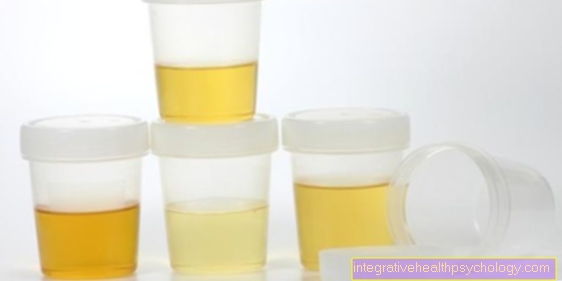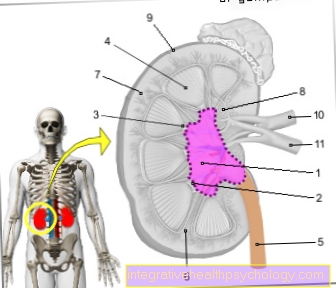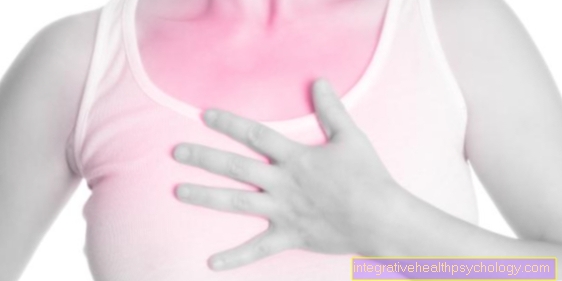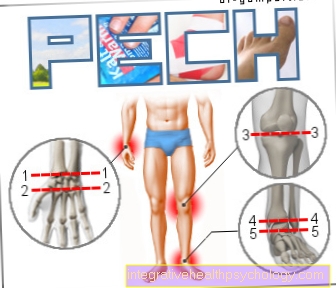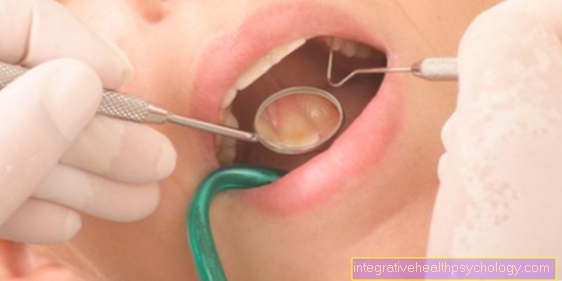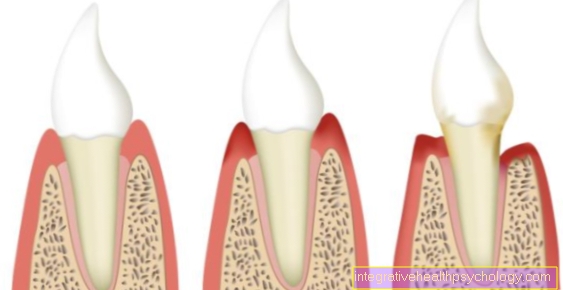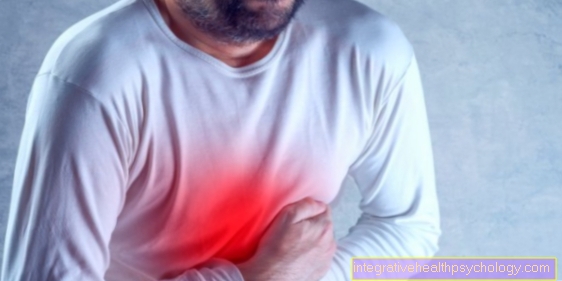Rash after vaccination
definition
A rash is one of the typical symptoms after vaccination.
Most of the time, reddening occurs accompanied by swelling at the vaccination site. In fact, these reactions are desirable, as they show that the body's immune system is dealing with the vaccine.

In this respect, this slight reddening at the puncture site is completely harmless. It usually occurs in the days after the vaccination and disappears again within a few days.
After vaccination with the combination preparation against mumps, measles and rubella (MMR), a harmless rash often occurs about a week after the vaccination. This can be associated with itching or heal without itching at all. This is the case in approx. 5% of the vaccinated children, often accompanied by a slight fever and malaise.
The symptoms subside after a few days.
Read more about this under Measles vaccination and measles rash
causes
The local vaccine reaction, where there is redness and swelling around the puncture site, is considered a positive sign as the body responds to the vaccine with a defense reaction. In this respect, this slight reaction shows that the vaccine is working and the body is training its defense cells against the respective pathogen. This guarantees protection against infectious diseases.
The redness is often associated with mild pain (similar to feeling sore muscles), but these symptoms are completely harmless and have nothing to do with an intolerance or allergy to the vaccine. The symptoms disappear after just a few days.
Another type of rash that can affect the whole body, not just the vaccination site, is a reaction to a combination vaccination of mumps, measles, and rubella. About 5% of vaccinated children react to the vaccination with a harmless rash. This occurs after about 5 to 10 days and can proceed with or without itching. The rash is often accompanied by a slight fever and malaise. However, the symptoms subside after a few days. Serious vaccination side effects such as febrile convulsions or meningeal irritation only occur in very rare cases.
Another cause of rashes after vaccinations can be an allergy to an ingredient in the vaccine. This occurs in very rare cases and can manifest itself on the skin as a rash, which can also be accompanied by severe itching. The allergic reaction can only manifest itself in a rash, or it can be accompanied by itching and asthma or even lead to allergic shock. The latter, however, occurs extremely rarely.
If you are allergic to egg white, you may experience allergic reactions such as a rash or airway narrowing if the vaccine was produced in chicken embryos. Such a vaccine can e.g. be against influenza or yellow fever. The vaccine against mumps, measles and rubella is grown on so-called chicken fibroblasts, which means that hardly any traces of chicken protein get into the vaccine. Thus, a chicken protein allergy is no longer an exclusion criterion for the MMR vaccination.
Read more about this under Causes of a rash
Concomitant symptoms
Often a harmless rash after a vaccination of general symptoms like Exhaustion, slightly increased body temperature and Headache or body aches accompanied. Also Gastrointestinal problems can occur. Often there is also a slight swelling and pain at the injection site, which can be reminiscent of sore muscles. The symptoms mentioned occur frequently to very frequently, depending on the vaccine, and are harmless. Here it is sufficient to take it easy for a few days and to give the body time to defend itself against the vaccine with its own immune cells.
With the so-called "vaccine measles" there is not only the typical rash but also an increased temperature and sometimes a swelling of Lymph nodes. It is extremely rare for mumps or measles to break out in their full clinical picture as a result of the vaccination. Just like that come the dreaded complications like Febrile seizures or Meningitis, before them Vaccination opponents permanently warn extremely rare.
In addition, it has not been conclusively proven how many of the dramatic cases can really be attributed to the vaccination, and in which cases the vaccination was only temporally related to the occurrence of febrile convulsions or meningitis.
In the event of an allergic reaction to the vaccine with a rash, itching is also common. Asthma-like symptoms and shortness of breath may occur less frequently. Allergic shock is extremely rare.
diagnosis
The time correlation with a previous vaccination is crucial for the diagnosis. If the reddening occurs locally around the puncture site and is accompanied by symptoms such as local swelling and slight pain, the doctor can immediately tell that it is a harmless vaccination reaction. Often, general symptoms such as malaise, Body aches or a headache on.
A diagnosis that the doctor can also make as a visual diagnosis are the so-called "Vaccine measles". The children develop a mild fever and a measles-typical rash about one to two weeks after the vaccination. The children are generally not contagious and the symptoms subside after a few days without complications.
An allergic reaction to a vaccine can occur immediately or after a few days; the doctor can often find out whether the patient suffers from other allergies or whether similar symptoms have already occurred during previous vaccinations.
Treatment / therapy
A rash after vaccinations does not require any special therapy. In the case of redness that is locally limited to the puncture site and is accompanied by pain and swelling, it can help to apply ice to the area cool. The reddening will then go away on its own after a few days. The situation is similar with the measles-typical rash after a mumps-measles-rubella vaccination. Here, too, there is no causal therapy; any existing itching can be reduced with cooling ointments.
If there is a suspicion of an allergy, attention should be paid to the ingredients of the vaccine before further vaccinations. If only a rash without shortness of breath or Shock symptoms occurs, no further special therapy is required here either.
homeopathy
A rash after vaccination will heal itself within a few days without the need for special therapy. Those affected who have had good experiences with homeopathy can try to reduce the duration of the rash with appropriate preparations To shorten. A science proofthat the duration of the rash or feeling of illness after vaccination can be shortened with homeopathic medicines, does not currently exist. Depending on the type of rash (with or without itching, with blisters, flaking or oozing, etc.), a variety of different homeopathic active ingredients can be used.
Duration of the rash
A local vaccination reaction around the puncture site in the form of redness, swelling and pain disappears by itself within a few days. The situation is similar with the rash in the case of the “vaccine grains”, where the slightly increased body temperature and the rash disappear without any complications after a few days without therapy. If you are allergic to the vaccine, the rash will usually go away even after a few days.
In general, if you get a rash after a vaccination, there is nothing to worry about. If the rash and accompanying symptoms are like feverIf, however, malaise or headaches and body aches persist for a long time, the attending physician should be consulted.
Rash after tetanus vaccination
Against tetanus (Tetanus) is usually shared with diphtheria and Pertussis (whooping cough) vaccinated, so the vaccine is a triple vaccine (see Infanrix®). The triple vaccine and not a single vaccine only against tetanus is used both for the basic immunization in toddlers and for the booster every 10 years in adolescence and adulthood. Even if the doctor gives an injection against tetanus as a precautionary measure after an injury with an unclear vaccination status of the patient, it is usually a triple combination. This is very well tolerated, both for children and adults. Local skin rashes only occur in a few cases, and allergic reactions are very rare.
A single vaccination against tetanus only can be given if e.g. a intolerance against the diphtheria or pertussis vaccine.
Infanrix
Infanrix® is the trade name of a triple vaccine that is said to immunize against diphtheria, tetanus and pertussis. According to the recommendation of the STIKO (Standing Vaccination Commission), this triple vaccination is part of the basic immunization that every child in Germany should receive. The vaccine can be administered from the second month of life and must be vaccinated four times in order to achieve basic immunization in the toddler. As a result, the vaccination protection must be refreshed every ten years.
The vaccine is generally considered to be well tolerated. During the primary vaccination course, local reddening or swelling occurs in only 0.1% of cases, while booster vaccinations can cause reddening around the injection site in up to 5% of cases. There have been rare reports of inflammatory skin conditions temporally related to vaccination. Allergic reactions, which may include a rash, have been reported very rarely.
Rash after hepatitis vaccination
The Standing Vaccination Commission (STIKO) recommends vaccination against Hepatitis B. for all newborns as a basic vaccination. Adults at increased risk of infection, such as healthcare workers, people with changing sex partners, and many other risk groups should also be vaccinated against the hepatitis B virus.
At Hepatitis A Above all, foreign travelers (especially to southern countries) and health care workers should be protected. There is a separate vaccine for hepatitis A and B as well as a combination vaccine (e.g. Twinrix®).
The vaccination is considered well tolerated, but in about one out of ten cases there is pain and reddening at the injection site. Swelling and itching can also develop at the injection site. It can also be relatively common Exhaustion and Diarrhea, such as nausea come.
Rash in adults
Adults can develop a rash with either a primary or booster vaccination. Even in adulthood, a vaccination with the MMR vaccine (against mumps, measles, rubella) can lead to a measles-typical rash. However, since mumps, measles and rubella are so-called childhood diseases, the vaccination should even in toddler age respectively. However, adults who are not vaccinated against MMR can get the vaccination to protect children around them. In addition, the vaccination is recommended, as adults can also get these childhood diseases, and sometimes the disease increases in adults difficult courses With Meningitis or results in infertility.
In addition, various booster vaccinations (e.g. tetanus, diphtheria, polio) or initial vaccinations (travel vaccinations such as hepatitis A, yellow fever, etc.) in adulthood can lead to local redness around the injection site. In adults, allergic reactions to a vaccine, which are also accompanied by a rash, are much less common.
Rash on baby

In the generally recognized vaccination calendar of the STIKO (permanent vaccination commission), the first basic immunization (G1) for many infectious diseases such as diphtheria, pertussis, tetanus or polio is provided for as early as the 2nd month of life. At this age, the children's defense system is already able to defend itself against the vaccine by developing defense mechanisms against the real pathogen.
In general, a rash after a vaccination is possible with any vaccine, especially reddening around the injection site is also common in babies. In about 5% of cases, children who have been vaccinated against measles, mumps and rubella develop a measles-typical rash, which can spread over the face and all over the body ("vaccine measles"). This rash can occur both with the first and the following MMR vaccinations and disappears after a few days without causing complications. The babies often have a slight fever and malaise.
Read more about this under Vaccinations in the baby


